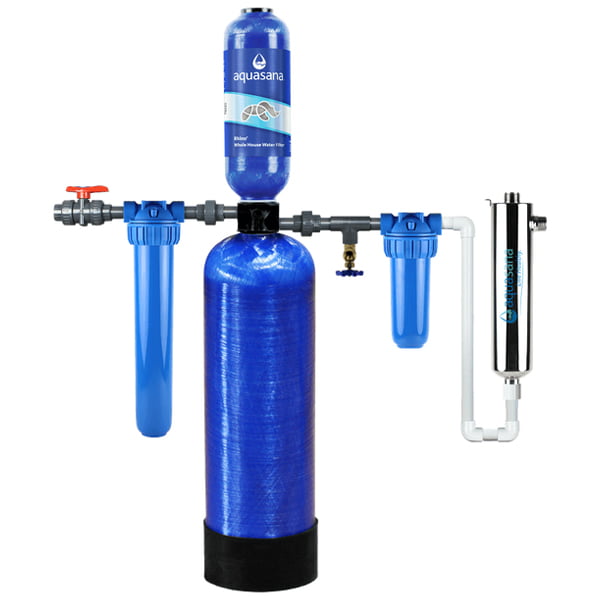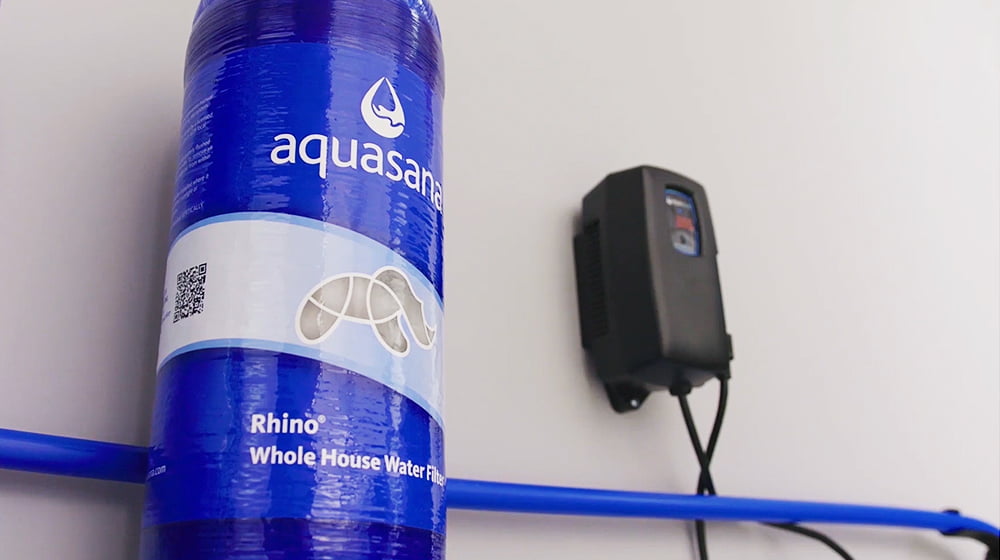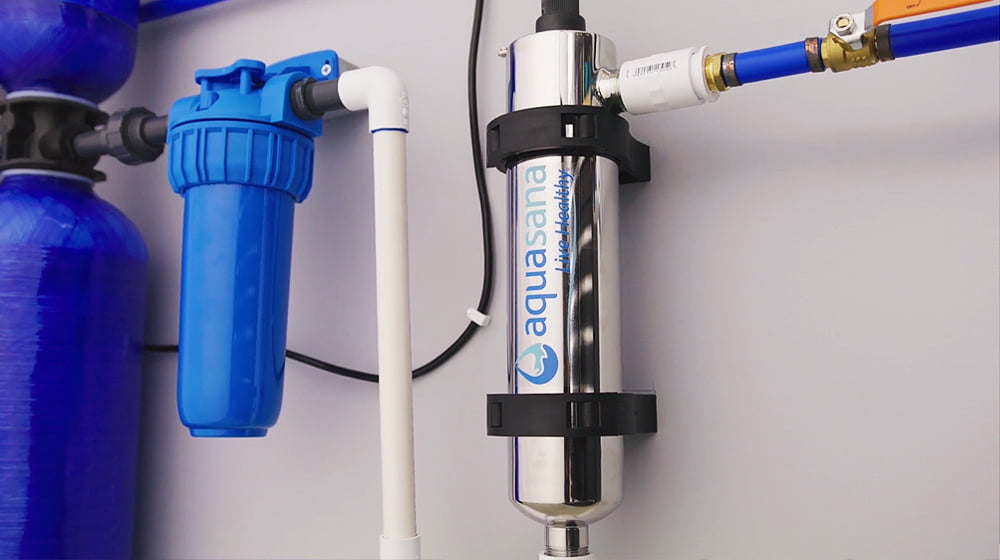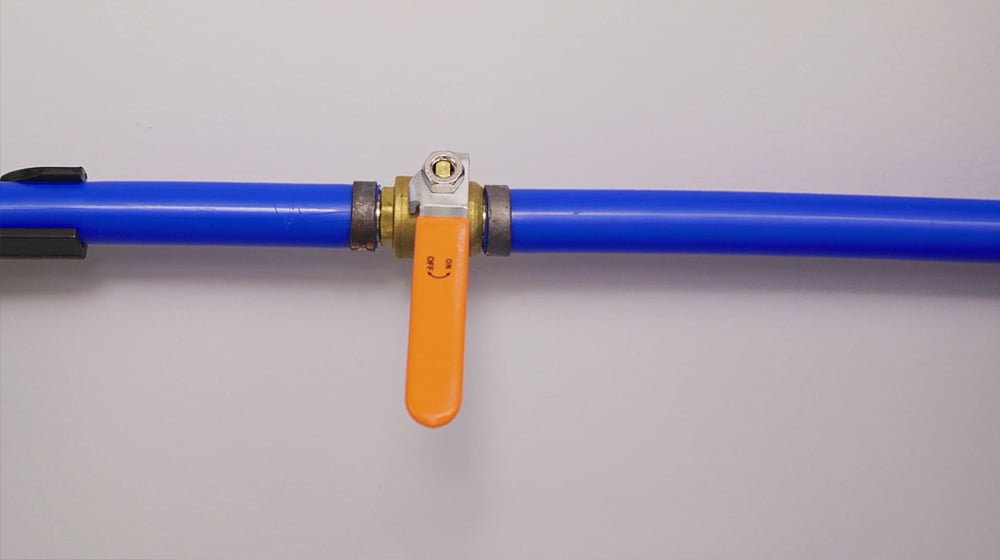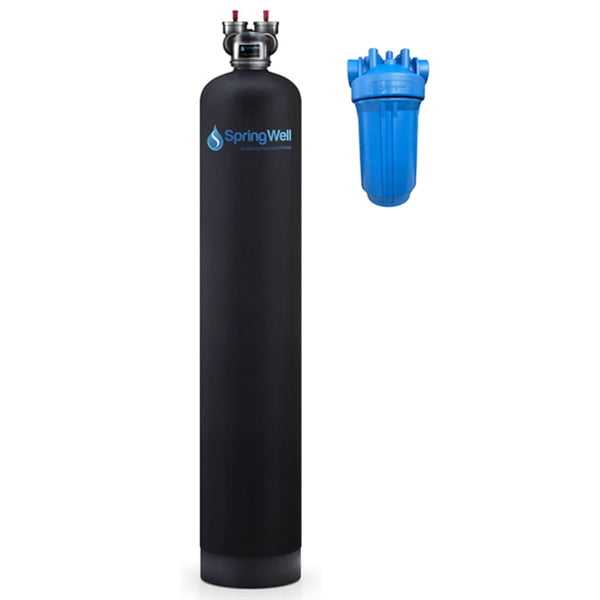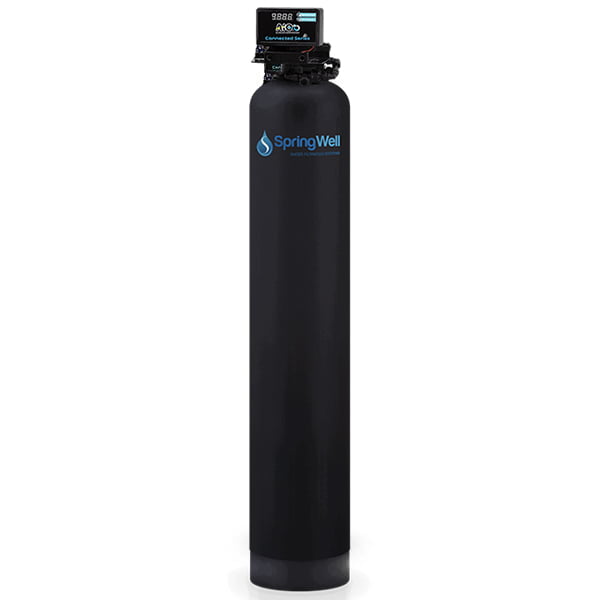Review: Aquasana Rhino Whole House Well Water Filtration System
Written by: Gene Fitzgerald // Expert Fact-Checking: Buddhini Dolapihilla, MBSS // Last Updated: Aug 10, 2023
This page may contain affiliate links. If you buy a product or service through such a link we earn a commission at no extra cost to you. Learn more.
The Aquasana Rhino Whole House Well Water Filtration System uses a 5-stage process to provide better-tasting and healthier water to your entire home.
It even includes a UV filter which eliminates over 99% of bacteria, viruses, and cysts. We also have easy filter changes and a relatively low price tag.
Let’s take a closer look at the system and see how it stacks up against the competition.
Aquasana Rhino Whole House Well Water Filtration System – All Specs
- Model: WH-WELL-UV
- Last Price: $1,399.00
- Annual Maintenance Cost: ~$240
- Filter Media/Process: Sediment Pre, Activated Carbon, KDF, Sediment Post, UV
- Filter Stages: 5
- Flow Rate: 7 gpm
- Filtering Capacity: 500,000 gal or 5 Years
- WxHxD: 40″x57″x10.5″
- Water Temperature: 40-90 °F
- Water Pressure: 20-100 psi
- NSF Testing: Standard 55 (Cysts, Bacteria, Viruses)
- Warranty: 5 Years
Aquasana – Discount Code
You can use our code “AQBOS50“ to get up to 50% discount on any purchase you make on aquasana.com.
Aquasana Rhino WH-WELL-UV – Key Features
So, the Aquasana’s WH-WELL-UV filter is a 5-stage system designed to provide filtration for any home supplied by well water. The filtration will improve both the taste and aesthetics of your water in addition to removing sediments, waterborne pathogens, few heavy metals, pesticides, VOCs, and other organic chemicals – resulting in higher-quality water overall that’s also healthier.
The 5 filter stages:
- Standard 20″ pre-filter removes sediment, rust, and silt.
- Activated carbon filter removes up to 97% of chlorine taste and odor, pesticides, herbicides, VOCs, industrial solvents, and other organic contaminants.
- KDF media in the primary well tank (extends the life of your system, reduces certain water-soluble heavy metals, and inhibits bacteria and algae growth).
- Post-filter adds a final polish, reducing any remaining sediment and organic particles.
- NSF-certified UV filter sterilizes water, eliminating 99.99% of viruses, bacteria, and 99% of cysts.
The system is designed to last for 5 years or 500,000 gallons and comes with a limited lifetime warranty plus a 90-day money-back satisfaction guarantee.
The 7-gallon per minute flow rate provides enough water to supply about 2.5 bathrooms. This is enough for most small to medium-sized homes, but larger homes are likely to run into pressure issues.
The regular system doesn’t come with a bypass valve included, but the optional installation kit includes one. Other optional upgrades available are a salt-free water condition stage and a low-maintenance pre-filter that requires less frequent cartridge changes.
Gallery
Aquasana Well Water Filter Pros
The primary advantage of the Aquasana Rhino whole house well water filter is its broad filtration. Activated carbon, KDF media, sediment filters, and UV filtration will remove a wide array of impurities and potentially harmful contaminants. This will protect your entire plumbing system from clogging and similar issues and also protect the health of your family.
Installation requirements are okay for a whole house system (the optional pro-grade bypass kit makes it easier.)
Pre and post-filter cartridge changes are simple and quick to perform with the included filter wrench. Tank changes are also designed to be quick and simple.
What Contaminants Are Being Removed?
The 5-stage filtration process will remove a bunch of different contamination types found in well water.
- The pre-filter traps sediments and other large particles. This protects the later stages from clogging as well as extend the lifespan of your home’s water-consuming appliances.
- Next, activated carbon removes chlorine taste and odor, pesticides/herbicides, VOCs, and industrial solvents.
- In the same tank, copper-zinc media removes certain heavy metals as well as stops the growth of harmful microorganisms inside your tank.
- The post-filter polishes the water’s flavor and removes any residual sediment/organics.
- Lastly, the UV filter kills off bacteria, viruses, and cysts.
The Aquasana Rhino WH-WELL-UV – learn more on Aquasana.com
Installation
Installation is no more complex than with other whole house water filters. Provided you have basic DIY and plumbing skills you should be able to install the system on your own.
Tools and materials needed for installation:
- Drill
- Adjustable wrench
- Channel locks
- Pipe cutter or hacksaw
- NSF-certified plumber’s tape
- NSF-certified PVC primer and glue
- Bucket
- Garden hose
- Grounding wire and clamps (if needed)
The tank must be installed in an upright position to maximize contact with the filter media. Be sure to only use plumbers’ tape on fittings and not pipe dope or PVC primer/glue.
How to install the system step-by-step:
- First, plan your installation location. Assemble the system in the correct sequence and mark the installation location on your home’s main water line.
- Now you’ll need to prepare the main filter tank.
- First, make sure it’s sitting completely level on the ground.
- Assemble all parts and fittings running in and out of the tank. Coat the fittings using NSF-approved primer.
- Connect the necessary fittings to the tank’s inlet and outlet ports.
- Hand tighten and then use the included filter wrench to snug. Be careful not to overtighten.
- If installing the system on copper pipes, you’ll want to install grounding clamps to maintain electrical grounding. Secure a clamp to the pipe on each side of the system, and run a #4 copper wire in between.
- Now, shut off your system’s main water line, and drain the pipes by opening a faucet downstream.
- Use a pipe cutter or hacksaw to cut into the main water line. Use a bucket to catch any water. Loosely connect the included shutoff valve to the main water line.
- Now, measure and mark the total system length including add-ons on the pipe.
- Cut the pipe, and clean up any burrs or sharp edges using a file.
- Now, you’ll need to assemble your system.
- First, attach the shut-off valve to the incoming section of your water line.
- Then, join the shutoff valve with the system inlet using the plumber’s tape.
- Join the pre-filter wall bracket and the system with the bundled screws. Then, mount the bracket to the wall.
- Make sure all of the fittings and stages are assembled correctly per the instructions.
- Now, mount the post-filter bracket to the wall and attach the post-filter.
- The final stage involves flushing the system to remove any small carbon particles.
- Attach a garden hose to the drain valve.
- Open the drain valve, and run the hose into a floor drain.
- Turn the water on slowly at the shutoff valve. Check the system for leaks. If no leaks are detected continue flushing.
- Let the water flow for 15 minutes. The first several gallons out of the system will be dark and cloudy from the fine carbon particles.
- Now, surge flush the system by running the water for 30 seconds and then shutting it off for 30 seconds. Do this until the water coming out of the drain is completely clear.
- Installation is now complete!
Video
The Package (Parts)
- Rhino Well Water System
- 20″ Pre-Filter
- 10″ Post-Filter
- UV Filter
- Filter Wrench
- 2x Filter Support Brackets
- 2x 1″ – 3/4″ Reducer Bushings
- Shut-Off Valve
- 2x Slip Unions
- 5x 2.5″ TOE Nipples
- 3″ Smooth Nipple
- Brass Drain Valve
- PVC Tee
Maintenance
The Aquasana Rhino well water filter requires regular filter cartridge changes to operate effectively.
The manufacturer recommends changing the pre-filter every 2 months, the post-filter every 6 months, and the UV lamp every 12 months. In total, this comes to about $240 annually.
The tank will also need replacement every 5 years or so, consult the manual for detailed instructions.
To change the pre and post-filters:
- Turn off the shut-off valve and place a bucket under the drain valve. Open the drain valve and collect any water in the system.
- Use the included filter wrench to loosen the filter housing from the unit head. Remove and discard the old filter cartridge.
- Clean out the filter housing interior with mild soap and water.
- Insert a new filter into the filter housing.
- Wipe the housing O-ring clean and lubricate with silicone lubricant. Ensure the ring is set in the groove and connect the housing to the unit head.
- Open the shutoff valve to turn the system on.
- Run the system with the bucket still in place to catch any water in case of leaks.
Manual
Here is a link to the official manual:
NSF and Other Certifications
The system has been independently tested (not certified) to NSF/ANSI Standard 55. It will remove 99.99% of bacteria and viruses, and 99% of cysts according to the manufacturer.
Earlier Product Versions
The system has an earlier version called the Aquasana Rhino EQ-500. Both versions seem to be identical except for the name.
Rhino Whole House Well Water Filter Cons
While the Aquasana Rhino WH-WELL-UV seems quite impressive overall, there are a few drawbacks worth mentioning.
First, the pre-filter must be replaced every 2 months. This isn’t an issue in terms of cost, as annual pre-filter costs are only $60, but means you’ll need to perform filter changes frequently. You can also opt for the low-maintenance pre-filter to avoid this issue, but that means shelling out more money.
A related issue is the lack of an included bypass valve with the regular kit. This can be easily remedied by purchasing the optional bypass kit, but again that requires spending additional money.
Several users had problems with the system malfunctioning when iron was present in the water. Aquasana states that the system is not designed to remove iron, and in cases with significant iron present in water, an iron pre-filter is required. In any case, this is something to be aware of when considering the system.
A small proportion of users also had bad experiences when dealing with Aquasana’s customer service. This was not the majority, but again something to be aware of when considering an expensive system like this.
Another minor drawback is the lack of official NSF testing and certification. While the UV filter is independently tested to NSF Standard 55, we would like to have seen additional testing and certifications for the rest of the system.
Aquasana Rhino WH-WELL-UV Review: Our Verdict + Best for
Overall, the Aquasana Rhino Whole House Well Water Filtration System offers solid sediment, activated carbon, and KDF media filtration. This will remove particles, chlorine, and several other water contaminants. The UV filter is a nice touch and will eliminate any potential microbial contamination.
However, the system won’t remove iron, manganese, hydrogen sulfide, and other tricky contaminants often found in well water. This makes it a little underwhelming – especially as it’s marketed as a ‘well water’ system.
The other major concern is the mediocre flow rate of 7 gallons per minute. This is adequate for small to medium size homes but is too low for larger houses.
Our Rating in Detail:
- Filtration Performance: 3.5/5.0
- Filter Capacity (Life): 4.0/5.0
- Purchase Price: 4.0/5.0
- Annual Cost: 4.0/5.0
- Overall: 3.5/5.0
Get Up to 50% Off! Use Code: AQBOS50
Comparison to Other Whole House Water Filters
To better evaluate the Aquasana Rhino, let’s see how it compares to some of the most popular whole house filtration systems – the SpringWell CF and the SpringWell WS.
First, the SpringWell CF (get the full review here) is a tank-based whole house water filter that also features KDF media and sediment pre-filtration but uses catalytic carbon rather than basic activated carbon. This means it will also remove sulfur/hydrogen sulfide from water – which is a common issue with well supplied water.
The SpringWell CF also has significantly better flow rates of between 9 and 20 gallons per minute depending on the specific model, plus annual filter replacements only cost $40. Additionally, the filter capacity is 1 million gallons – double the Aquasana Rhino’s. The SpringWell CF doesn’t come with a UV filter, but you can add one as an upgrade if desired.
The WS is SpringWell’s dedicated well water filter system (review here) and is ideal for removing the contaminants most commonly associated with well water – the tank-based system features air injection oxidation and greensand media which will remove iron, manganese, and hydrogen sulfide for about 10 years without replacement. It also has a high flow rate of 12 to 20 gallons per minute. A spin-down sediment filter removes large particulates. As with the SpringWell CF, an optional UV filter can be added on if desired.
Overall, both of the SpringWell systems would make better options for well water filtration in most scenarios. Both systems have limited lifetime warranties and 6-month money-back satisfaction guarantees. The WS would be preferred when dealing with iron/manganese/hydrogen sulfide, while the CF offers catalytic carbon filtration which is highly effective at removing chlorine/chloramine as well as sulfur.
This completes our review of the Aquasana Rhino Whole House Well Water Filtration System. If you have any questions please don’t hesitate to leave a comment below!
Information provided on BOS is for educational purposes only. The products and services we review may not be right for your individual circumstances.
We adhere to strict editorial guidelines. Rest assured, the opinions expressed have not been provided, reviewed, or otherwise endorsed by our partners – they are unbiased, independent, and the author’s alone. Our licensed experts fact-check all content for accuracy. It is accurate as of the date posted and to the best of our knowledge.

